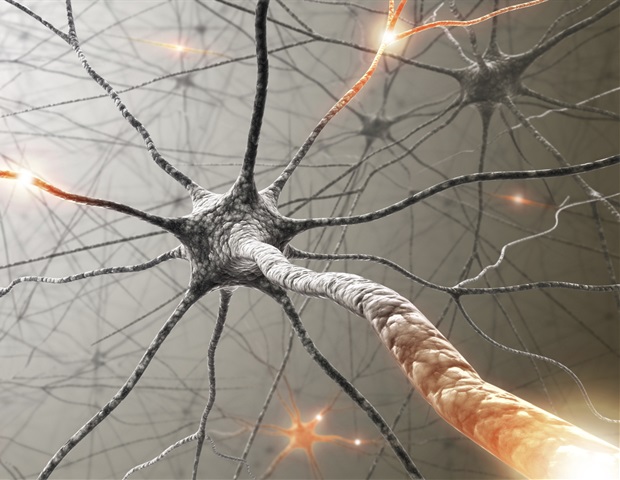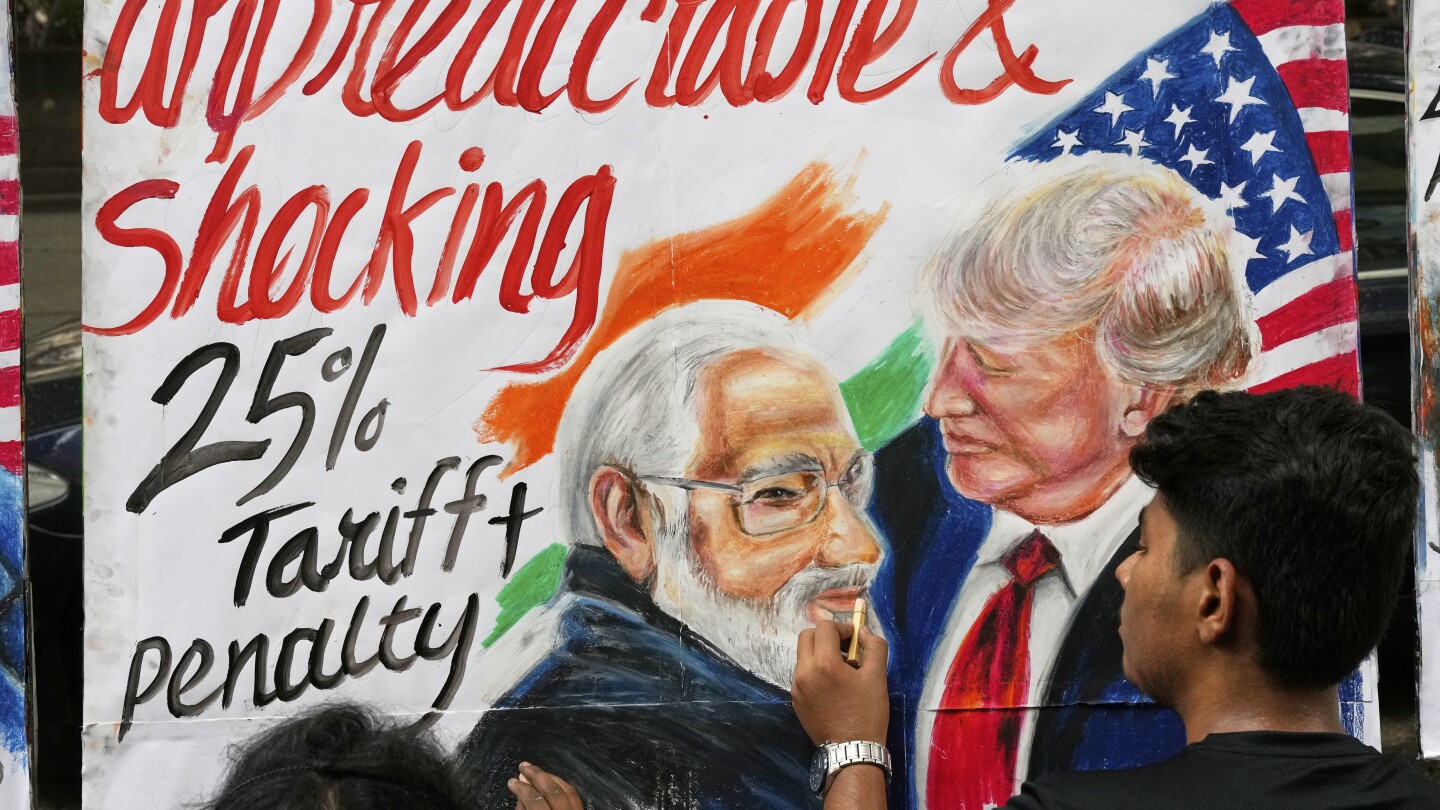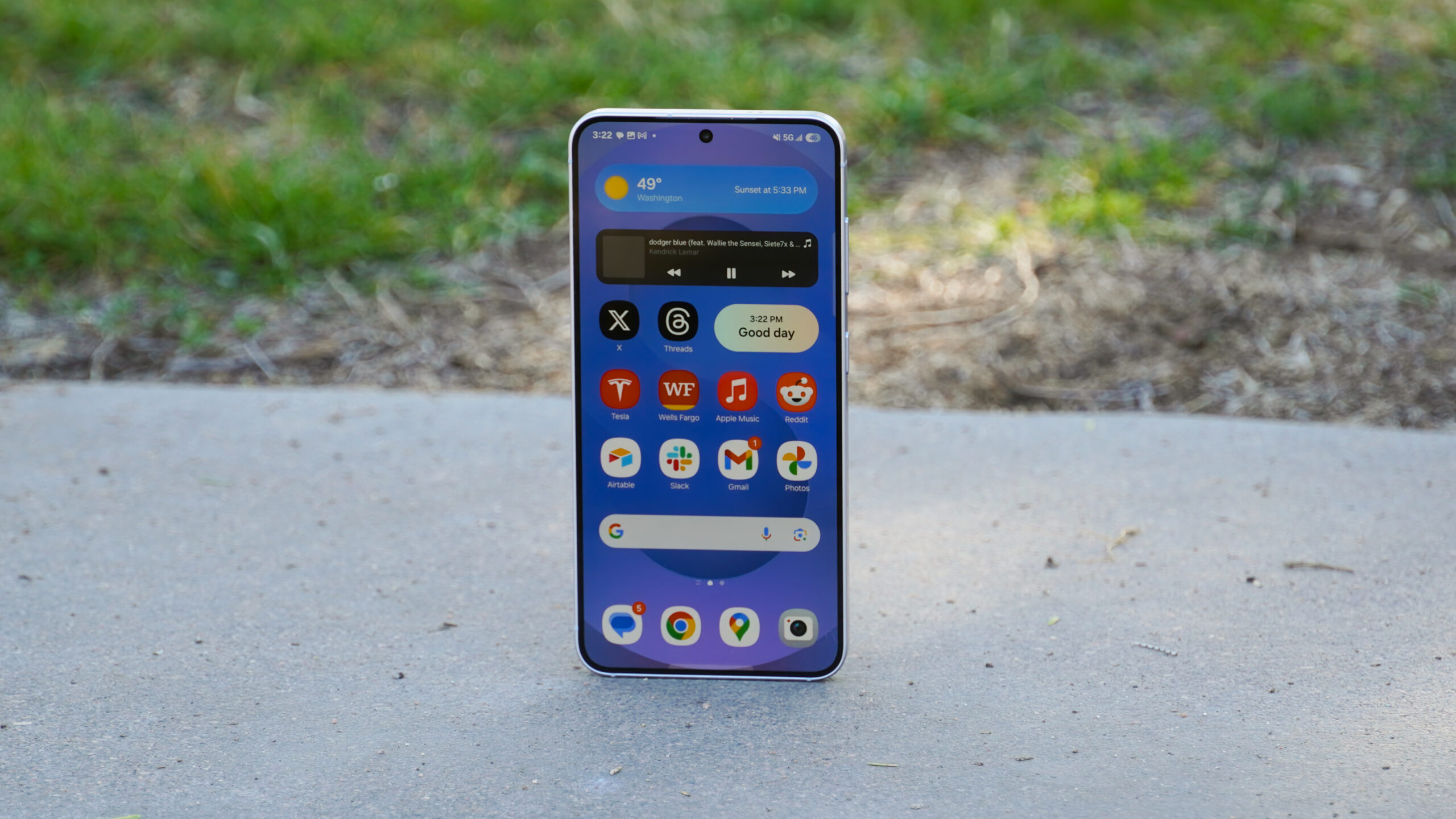- Toyota, Honda brace for profit falls as US tariffs, strong yen weigh Reuters
- Toyota, Honda Brace for Impact After Trump Auto Tariffs, Stronger Yen Bloomberg.com
- The 15% mistake? Toyota rises as U.S. tariff strategy backfires Investorsobserver
- US tariffs doing real damage to Japanese profit margins ING THINK economic and financial analysis | ING Think
- Toyota suppliers, Denso look to pass on tariff costs with price hikes Automotive News
Blog
-
Toyota, Honda brace for profit falls as US tariffs, strong yen weigh – Reuters
-

New insights reveal how sugar metabolism protects neurons from degeneration
Unlike most cells in the human body, neurons-the functional cells of our nervous system-cannot typically replace themselves with healthy copies after being damaged.
Rather, after an injury from something like a stroke, concussion or neurodegenerative disease, neurons and their axons, fiber-like projections that relay electrical signals, are far more likely to degrade than regenerate.
But new research from the University of Michigan opens new ways to think about neurodegeneration that could help protect patients against that degradation and neurological decline in the future. The study, published in the journal Molecular Metabolism, could even bring us a step closer to understanding the rare cases when brains do heal and open new pathways to developing treatments, the researchers said.
Their findings, made using a well-established fruit fly model, suggest that how resilient neurons are to degradation is connected to the fundamental process of how these cells process sugar. The work was supported by the National Institutes of Health, the U.S. National Science Foundation, the Rita Allen Foundation and the Klingenstein Fellowship in the Neurosciences.
“Metabolism is often changed in brain injury and diseases like Alzheimer’s, but we do not know whether this is a cause or consequence of the disease,” said senior author Monica Dus, U-M associate professor of molecular, cellular, and developmental biology.
“Here we found that dialing down sugar metabolism breaks down neural integrity, but if the neurons are already injured, the same manipulation can preemptively activate a protective program. Instead of breaking down, axons hold on longer.”
Postdoctoral research fellow TJ Waller, the lead scientist in the study, found that two particular proteins appear to be involved in extending the health of axons. One is called dual leucine zipper kinase, or DLK, which senses neuronal damage, and is activated by a disrupted metabolism. The other protein is known as SARM1-short for Sterile Alpha and TIR Motif-containing 1-which has been implicated in axon degeneration and is coupled with the DLK response.
“What surprised us is that the neuroprotective response changes depending on the cell’s internal conditions,” Dus said. “Metabolic signals shape whether neurons hold the line or begin to break down.”
Generally, in cases where neurons and axons don’t degrade, DLK becomes more active and the movement of SARM1 is suppressed. But there are wrinkles. In fact, prolonged DLK activation over time leads to progressive neurodegeneration, the study showed, effectively reversing earlier neuroprotective effects.
DLK, in particular, has emerged as a target for treating and studying neurodegenerative disease. But researchers will need to confront technical challenges to control DLK’s dual harmful and beneficial functionality, Waller said.
“If we want to delay the progression of a disease, we want to inhibit its negative aspect,” Waller said. “We want to make sure that we’re not at all inhibiting the more positive aspect that might actually be helping to slow the disease down naturally.”
Mediating a molecule like DLK’s double functionality presents a compelling puzzle researchers have yet to solve. Uncovering the mechanisms underlying how modulators like DLK switch between these protective and harmful states could hold massive implications for the treatment of neurodegenerative disease and brain injury, directly impacting clinical populations.
Dus and Waller said that understanding this mechanism “provides a new perspective on injury and disease, one that goes beyond simply blocking damage to focusing on what the system is already doing to reinforce it.”
Source:
Journal reference:
Waller, T. J., Collins, C. A., & Dus, M. (2025). Pyruvate kinase deficiency links metabolic perturbations to neurodegeneration and axonal protection. Molecular Metabolism, 98, 102187. https://doi.org/10.1016/j.molmet.2025.102187
Continue Reading
-

First-of-Its-Kind Israeli Study Reveals Insects ‘Listen in’ on Plants
Discover the hidden world of plant sounds.
Aug 5, 2025

(Tomasz Klejdysz / Shutterstock.com)
A still forest, far from the hustle and bustle of city life, is perceived as serene and quiet. Perk up your ears and you may hear no more than wind softly rustling leaves and the gentle buzz of insects.
However, groundbreaking findings indicate nature isn’t so quiet after all. Not only does vegetation make sounds beyond the human range of hearing, CNN reported, but small critters “eavesdrop” on this “silent” clamor and adapt behavior based on these noises.
Talking Plants
In a major discovery, researchers in Israel have documented that insects can hear and interpret acoustic signals from plants under stress.The findings show us a bigger picture into the interactions of the plant and animal world. The research team previously recorded sounds from tomato and tobacco plants that were dehydrated. The noise created was a result of changes in the plant’s water balance.
During periods where the plants lack water, air bubbles form, expand and collapse in xylem tissues, which are responsible for distributing water from the roots. This produces vibrations and click-like sounds.
Cotton Leafworm Moths Listen In
In the study published in eLife, scientists from Tel Aviv University conducted a series of experiments where they observed Egyptian cotton leafworm moths detecting ultrasonic signals emitted by drought-stressed tomato plants. These subtle sounds help female moths choose where to lay their eggs.In one experiment, when there were no plants present, the female moths preferred the side of the arena where the sounds of stressed plants were played. This suggests that the moths may have associated the sound with the presence of vegetation.
However, when healthy plants were placed on two sides, where only one played the sound of distressed plant clicks, the moths chose to lay their eggs on the silent side.
As part of the research, when the moths’ sense of hearing was removed, they no longer showed a preference for where to lay their eggs. This suggests that sound plays a key role when it comes to moths choosing the best environment for their offspring.
The Tip of the Iceberg
The new discovery sheds light on the possibility of this invisible ecosystem, the BBC reported. “This is the first demonstration ever of an animal responding to sounds produced by a plant,” Professor Yossi Yovel of Tel Aviv University told the BBC.“This is speculation at this stage, but it could be that all sorts of animals will make decisions based on the sounds they hear from plants, such as whether to pollinate or hide inside them or eat the plant,” Yovel added. “You can think that there could be many complicated interactions, and this is the first step.”
According to CNN, Rya Seltzer, lead study author and an entomologist and doctoral student in the department of zoology at Tel Aviv University in Israel, believes this is only the beginning of discoveries in the field. “There are countless organisms that can hear in these frequencies, and potentially many more plant sounds we haven’t discovered yet. This is definitely just the tip of the iceberg,” Seltzer tells CNN.
The “secret lives” of plants and moths aren’t just fascinating. They may also have real-world applications. As scientists continue to tune in, much may still be waiting to be discovered, just beyond our perception.
YOU MIGHT ALSO LIKE:
Listen to Nature’s Chorus
Scientists Discover the Language of Plants
Orangutans Use Healing Plants
ADINA ROSEN,
CONTRIBUTERAdina is a writer who believes in the transformative power of words. She understands that everyone has a valuable story to tell. Adina’s goal is to learn new things every day and share her discoveries with others.
Continue Reading
-

Modi and Trump once called each other good friends. Now the US-India relationship is getting bumpy
NEW DELHI (AP) — The men shared bear hugs, showered praise on each other and made appearances side by side at stadium rallies — a big optics boost for two populist leaders with ideological similarities. Each called the other a good friend.
In India, the bonhomie between Prime Minister Narendra Modi and U.S. President Donald Trump was seen as a relationship like no other. That is, until a series of events gummed up the works.
From Trump’s tariffs and India’s purchase of oil from Russia to a U.S. tilt toward Pakistan, friction between New Delhi and Washington has been hard to miss. And much of it has happened far from the corridors of power and, unsurprisingly, through Trump’s posts on social media.
It has left policy experts wondering whether the camaraderie the two leaders shared may be a thing of the past, even though Trump has stopped short of referring to Modi directly on social media. The dip in rapport, some say, puts a strategic bilateral relationship built over decades at risk.
“This is a testing time for the relationship,” said Ashok Malik, a former policy adviser in India’s Foreign Ministry.
The White House did not immediately respond to a message seeking comment.
President Donald Trump, right, speaks with India’s Prime Minister Narendra Modi during a news conference in the East Room of the White House, Feb. 13, 2025, in Washington. (AP Photo/Ben Curtis, File)
Simmering tensions over trade and tariffs
The latest hiccup between India and the U.S. emerged last week when Trump announced that he was slapping 25% tariffs on India as well as an unspecified penalty because of India’s purchasing of Russian oil. For New Delhi, such a move from its largest trading partner is expected to be felt across sectors, but it also led to a sense of unease in India — even more so when Trump, on social media, called India’s economy “dead.”
Trump’s recent statements reflect his frustration with the pace of trade talks with India, according to a White House official who was not authorized to speak publicly and spoke on condition of anonymity to describe internal administration thinking. The Republican president has not been pursuing any strategic realignment with Pakistan, according to the official, but is instead trying to play hardball in negotiations.
Trump doubled down on the pressure Monday with a fresh post on Truth Social, in which he accused India of buying “massive amounts” of oil from Russia and then “selling it on the Open Market for big profits.”
“They don’t care how many people in Ukraine are being killed by the Russian War Machine. Because of this, I will be substantially raising the Tariff paid by India to the USA,” he said.
The messaging appears to have stung Modi’s administration, which has been hard-selling negotiations with Trump’s team over a trade deal by balancing between India’s protectionist system while also opening up the country’s market to more American goods.
“Strenuous, uninterrupted and bipartisan efforts in both capitals over the past 25 years are being put at risk by not just the tariffs but by fast and loose statements and social media posts,” said Malik, who now heads the India chapter of The Asia Group, a U.S. advisory firm .
Malik also said the trade deal the Indian side has offered to the U.S. is the “most expansive in this country’s history,” referring to reports that India was willing to open up to some American agricultural products. That is a politically sensitive issue for Modi, who faced a yearlong farmers’ protest a few years ago.
People walk by as students of Gurukul school of Art complete artwork of U.S. President Donald Trump and Prime Minister of India Narendra Modi, in Mumbai, India, Friday, Aug. 1, 2025. (AP Photo/Rajanish Kakade)
Trump appears to be tilting toward Pakistan
The unraveling may have gained momentum over tariffs, but the tensions have been palpable for a while. Much of it has to do with Trump growing closer to Pakistan, India’s nuclear rival in the neighborhood.
In May, India and Pakistan traded a series of military strikes over a gun massacre in disputed Kashmir that New Delhi blamed Islamabad for. Pakistan denied the accusations. The four-day conflict made the possibility of a nuclear conflagration between the two sides seem real and the fighting only stopped when global powers intervened.
But it was Trump’s claims of mediation and an offer to work to provide a “solution” regarding the dispute over Kashmir that made Modi’s administration uneasy. Since then, Trump has repeated nearly two dozen times that he brokered peace between India and Pakistan.
For Modi, that is a risky — even nervy — territory. Domestically, he has positioned himself as a leader who is tough on Pakistan. Internationally, he has made huge diplomatic efforts to isolate the country. So Trump’s claims cut a deep wound, prompting a sense in India that the U.S. may no longer be its strategic partner.
India insists that Kashmir is India’s internal issue and had opposed any third-party intervention. Last week Modi appeared to dismiss Trump’s claims after India’s Opposition began demanding answers from him. Modi said that “no country in the world stopped” the fighting between India and Pakistan, but he did not name Trump.
Trump has also appeared to be warming up to Pakistan, even praising its counterterrorism efforts. Hours after levying tariffs on India, Trump announced a “massive” oil exploration deal with Pakistan, saying that some day, India might have to buy oil from Islamabad. Earlier, he also hosted one of Pakistan’s top military officials at a private lunch.
Sreeram Sundar Chaulia, an expert at New Delhi’s Jindal School of International Affairs, said Trump’s sudden admiration for Pakistan as a great partner in counterterrorism has “definitely soured” the mood in India.
Chaulia said “the best-case scenario is that this is just a passing Trump whim,” but he also warned that “if financial and energy deals are indeed being struck between the U.S. and Pakistan, it will dent the U.S.-India strategic partnership and lead to loss of confidence in the U.S. in Indian eyes.”
India’s oil purchases from Russia are an irritant
The strain in relations has also to do with oil.
India had faced strong pressure from the Biden administration to cut back its oil purchases from Moscow during the early months of Russia’s invasion of Ukraine. Instead, India bought more, making it the second-biggest buyer of Russian oil after China. That pressure sputtered over time and the U.S. focused more on building strategic ties with India, which is seen as a bulwark against a rising China.
Trump’s threat to penalize India over oil, however, brought back those issues.
On Sunday, the Trump administration made its frustrations over ties between India and Russia ever more public. Stephen Miller, deputy chief of staff at the White House, accused India of financing Russia’s war in Ukraine by purchasing oil from Moscow, saying it was “not acceptable.”
Miller’s remarks were followed by another Trump social media post on Monday in which he again threatened to raise tariffs on goods from India over its Russian oil purchases.
“India is not only buying massive amounts of Russian Oil, they are then, for much of the Oil purchased, selling it on the Open Market for big profits. They don’t care how many people in Ukraine are being killed by the Russian War Machine,” Trump wrote.
Some experts, though, suspect Trump’s remarks are mere pressure tactics. “Given the wild fluctuations in Trump’s policies,” Chaulia said, “it may return to high fives and hugs again.”
India says it will safeguard its interests
Many expected India to react strongly over Trump’s tariff threats considering Modi’s carefully crafted reputation of strength. Instead, the announcement prompted a rather careful response from India’s commerce minister, Piyush Goyal, who said the two countries are working toward a “fair, balanced and mutually beneficial bilateral trade agreement.”
Initially, India’s Foreign Ministry also played down suggestions of any strain. But in a statement late Monday, it called Trump’s criticism “unjustified and unreasonable” and said it will take “all necessary measures to safeguard its national interests and economic security.”
It said India began importing oil from Russia because traditional supplies were diverted to Europe after the outbreak of the Ukraine conflict, calling it a “necessity compelled by global market situation.”
The statement also noted U.S. trade with Russia.
“It is revealing that the very nations criticizing India are themselves indulging in trade with Russia,” the statement said.
Students of Gurukul school of Art work on paintings of U.S. President Donald Trump and Prime Minister of India Narendra Modi, in Mumbai, India, Friday, Aug. 1, 2025. (AP Photo/Rajanish Kakade)
___
Associated Press writer Michelle L. Price in Washington contributed reporting.
Continue Reading
-
‘Wednesday’ is back: Netflix’s dark darling returns with Addams family drama and female power in season two
LONDON, Aug 5 — Actress Jenna Ortega and the creators of the hit Netflix series Wednesday are hoping to surpass expectations as the show returns to screens after almost three years.
The dark fantasy series’ first season, which premiered in November 2022, ranks as Netflix’s most popular English-language show of all time, with more than 252 million views in the first 91 days of release.
As well as reprising the titular role, Ortega, 22, took on executive producer duties for the new season. Filmmaker Tim Burton also returns as one of the directors and executive producers.
“I’ve always been very protective of the character. I just want to make sure that we’re always doing her justice,” said Ortega. “It’s the most we’ve ever seen her on screen so there’s a lot of room and opportunity to maybe go off track.
“Fortunately we have a really great creative team. I’m doing my best to be on it, but you also have people like Tim, who are monitoring.”
The second season sees Wednesday returning to Nevermore Academy as a celebrated hero, much to her dismay. She investigates new supernatural mysteries, while dealing with glitches in her psychic powers.
Wednesday also faces another nuisance — family. Her little brother Pugsley starts his studies at Nevermore and their parents are a frequent presence on campus.
‘Play of emotions’
Bringing the Addams Family to the academy allowed co-creators and showrunners Alfred Gough and Miles Millar to expand the storylines of the characters introduced in the first season and explore mother-daughter dynamics.
“We thought, wouldn’t that be, for Wednesday, the ultimate thorn in her side if Morticia (her mother) came to school,” said Millar.
Catherine Zeta-Jones, who plays Morticia, promised fast-paced scenes between the two.
“It’s a dance and a play of emotions,” Zeta-Jones said.
The season’s focus on female relationships stood out as one of its stronger points for Ortega.
“We’re so oftentimes taught to compete against one another and there’s always some sort of comparing game that people are going to enforce on you,” Ortega said.
“What I love about the women I am working with and the characters, every woman in this show wants to see the other succeed. I think that’s really important for young people to see today,” she added.
The sophomore season also introduces new characters, including Steve Buscemi’s Nevermore principal Barry Dort and the Addams family matriarch Grandmama Hester Frump, played by Joanna Lumley. Pop star Lady Gaga makes a guest star appearance as a teacher in Part 2.
Wednesday has already been renewed for a third season, with Gough and Millar in the writers’ room “cooking that up” and ready to go beyond.
“We have goalposts for other things. There could be spinoffs, there could be other iterations of the show,” Millar said. “It’s such a big world. We are excited to explore it as much as we can.”
Wednesday Season Two will be released in two four-episode installments, with Part One dropping August 6 and Part Two out on September 3. — Reuters
Continue Reading
-

Natural brain rhythms control stress hormone levels and alertness
Ōtākou Whakaihu Waka-led research has found stress-controlling brain cells switch on and off in a steady rhythm about once every hour – even when nothing stressful is happening.
Senior author Associate Professor Karl Iremonger, of Otago’s Department of Physiology and Centre for Neuroendocrinology, says these rhythms shape activity patterns and alertness.
“These bursts of brain cell activity seem to act like a natural ‘wake-up’ signal, and often lead to a rise in stress hormones, or cortisol.
“This world first research opens the door to exploring how these patterns affect health, mood, and sleep,” he says.
For the study, published in high-profile journal PNAS, the researchers used an optical technique called photometry to track brain cell activity of mice and rats.
“This involved shining light into the animals’ brains, allowing us to monitor brain cell activity over the day and night as the animals moved around freely. We could then look at how the activity of brain pathways is coordinated with sleep/wake patterns and stress hormone levels.”
A group of brain cells called corticotropin-releasing hormone (CRH) neurons were found to be particularly important for the daily rhythms of stress hormone release.
“These neurons turn on and off in a regular pattern about once every hour. Interestingly, we found that these changes were coordinated with patterns of sleep and waking which suggests that the pattern of release is coordinated with wakefulness or alertness.
“We also found when the CRH neurons were artificially activated, this changed the animals’ behaviour – animals that were previously quietly resting became hyper-active.”
Associate Professor Iremonger says the research findings may lead to a better understanding of how disrupted stress rhythms can result in changes in mood and disrupted sleep.
Drugs that decrease CRH stress neuron activity may also be beneficial at treating conditions associated with hyper-active stress responses.
“Our new research is helping us to understand how the brain controls these normal rhythms of stress hormone release. Knowing how these brain signals work will help us understand the links between stress hormone levels, alertness and mental health.”
Source:
Journal reference:
Zheng, S., Caroline, Young, C. K., Tripp, I., Dharshini Ganeshan, Power, E. M., Schwenke, D. O., Herbison, A. E., Kim, J. S., & Iremonger, K. J. (2025). Ultradian rhythms of CRH PVN neuron activity, behavior, and stress hormone secretion. Proceedings of the National Academy of Sciences, 122(31). https://doi.org/10.1073/pnas.2510083122
Continue Reading
-

TUMI Celebrates Grand Opening of First China Flagship Store at Shanghai Centre
A Milestone Moment Marked by Notable Guests, Immersive Experiences, and Elevated Design
HONG KONG SAR – Media OutReach Newswire – 5 August 2025 – TUMI, the leading international travel, lifestyle and accessories brand, celebrated the grand opening of its first China flagship store at the iconic Shanghai Centre. TUMI welcomed guests to an exclusive launch event in celebration of the flagship’s grand opening—an evening rooted in design, culture, and meaningful connection. This milestone flagship is the latest reflection of the brand’s continued investment in the region and its commitment to serving the global traveler with immersive, elevated and personalized retail experiences.
An Exclusive Milestone Celebration
A symbolic ribbon-cutting ceremony marked the occasion, drawing notable guests from across the region and beyond and featuring a special appearance by newly named Asia-Pacific brand ambassador Wei Daxun.
(Left) TUMI China, Senior Director Julian Yung, Vice President of Asia Pacific and Middle East Aris Maroulis, TUMI Asia-Pacific Brand Ambassador Wei Daxun, TUMI Creative Director Victor Sanz, Executive Vice President and COO of Shanghai Centre Byron Kan (Jian Bailuan), taking part in the ribbon-cutting ceremony. (Right) TUMI Asia-Pacific Brand Ambassador Wei Daxun at the new TUMI Flagship Store in Shanghai
TUMI Creative Director Victor Sanz said, “Returning to Shanghai and seeing everything come to life was incredible. The energy in the room, the conversations, the people – it was all truly inspiring. Everyone brought something unique to the moment, and that’s what made it unforgettable. I couldn’t imagine a better way to kick off this exciting chapter for TUMI here in Shanghai.”
Following the ribbon-cutting, over 500 esteemed guests were welcomed to an exclusive after party held inside the flagship. Guests explored the space and discovered a curated selection of TUMI’s premium collections, including Alpha Bravo and Harrison. The evening also celebrated the launch of Chapter 3 of the Uncompromisingly Light campaign, brought to life through the dynamic 19 Degree Lite collection and the presence of newly appointed Asia-Pacific brand ambassador Wei Daxun. The afterparty further elevated the evening with entertainment and interactive workshops, as guests enjoyed a bespoke fan-personalization experience that paid tribute to Shanghai’s cultural richness. Inspired by the city’s creative pulse and legendary skyline, TUMI’s personalization service introduced an exclusive Shanghai mold specially crafted for the event, enabling guests to create custom keepsakes. To conclude the full-day celebration, guests were invited to a dynamic in-store experience featuring curated music, fine wine, and exclusive customization offerings—seamlessly blending TUMI’s travel-forward ethos with the city’s vibrant creative spirit.

TUMI Creative Director Victor Sanz (left) and Vice President of Asia Pacific and Middle East Aris Maroulis addressed guests during the event, which also featured a variety of personalization workshops.
Immersive Store Design Featuring Art, Displays, and Activations
Rooted in TUMI’s commitment to purposeful, performance-driven innovation, each element of the flagship’s immersive design—from the sculptural façade to curved LED screens and evocative Journey art installation—seamlessly blends the brand’s signature minimalist luxury with modern architectural aesthetics.
Echoing the sculptural elegance of 19 Degree, the flagship’s bold exterior greets visitors with a cascading metallic panel façade defined by fluid contours. This striking design detail is a nod to the collection’s signature curvature and reflects the brand’s commitment to thoughtful craftsmanship—starting from the outside in. Conveying effortless elegance in motion, refined scenario-based displays showcase the full range of TUMI men’s, women’s and travel accessories throughout thoughtfully designed spaces. A distinctive open-concept VIP area presents meticulously curated premium travel and luggage offerings, while clients can visit the interactive materials wall to experience TUMI’s innovations in cutting-edge design material technology firsthand.
Unique to the Shanghai flagship is a dedicated art installation space that bridges TUMI’s design philosophy and local artisan culture. Rooted in respect for material integrity and purposeful craftsmanship, the debut work, Journey, was created from bamboo by renowned contemporary artist Xu Fei. Exploring the intersection of movement, intention, and form, Journey draws on the ancient Chinese cosmological concept of ’round heaven and square earth’—a balance of fluidity and grounding that echoes TUMI’s approach to design. The installation embodies the brand’s belief that travel is not just about where you’re going, but how you move through the world—with clarity, resilience, and meaning.
TUMI China Flagship Store at Shanghai Centre
Address: Room A02-B, Ground Floor East Department Store, 1376 West Nanjing Road, Jing’an District, Shanghai.
Opening hours: 10am – 10pm
For more information about the flagship opening, additional content, and brand updates, follow along on TUMI.com and @TUMITravel social media channels.
Hashtag: #TUMIThe issuer is solely responsible for the content of this announcement.
About TUMI
Since 1975, TUMI has been creating world-class business, travel, and performance luxury essentials, designed to upgrade, uncomplicate and beautify all aspects of life on the move. Blending flawless functionality with a spirit of ingenuity, we’re committed to empowering journeys as a lifelong partner to movers and makers in pursuit of their passions. For more about TUMI, visit
 TUMI.com and follow on
TUMI.com and follow on  Instagram,
Instagram,  TikTok,
TikTok,  Facebook, and
Facebook, and  YouTube.
YouTube.Source : TUMI Celebrates Grand Opening of First China Flagship Store at Shanghai Centre
This article was produced by Media OutReach, our trusted news partner. The views expressed and the content presented here are solely those of the author and may not reflect the opinions of Thailand Business News.

Continue Reading
-

Leptin could offer alternative to insulin for managing type 1 diabetes complication
More than a decade ago, researchers found that an acute complication of type 1 diabetes, diabetic ketoacidosis (DKA), can be resolved with the hormone leptin, even in the absence of insulin.
An analysis published today in The Journal of Clinical Investigation explains how leptin affects the brain and how it might be used in future therapeutics.
DKA happens when the body is unable to make insulin and begins to break down fat for fuel. This can lead to a life-threatening buildup of sugar (glucose) and ketoacids in the blood. Doctors have typically administered insulin to address the complication, authors noted.
But evidence now shows that, when insulin is insufficient, the brain plays a key role in driving DKA, according to the new analysis, based in literature and research that includes studies conducted at UW Medicine since 2011.
When the pancreas can’t make insulin, “the brain gets the message that the body is out of fuel, even if it’s not. This information is being communicated in part by a low blood level of the hormone leptin,” said senior author Dr. Michael Schwartz, professor of medicine, Division of Metabolism, Endocrinology and Nutrition at the University of Washington School of Medicine.
Leptin helps the brain regulate appetite and body weight. Leptin is produced by your body’s fat cells. The hormone is carried by the bloodstream into your brain, particularly an area called the hypothalamus. This is the part of your brain that controls when and how much you eat. Insufficient leptin leads the brain to activate circuits that mobilize energy sources, including glucose and ketones.
Schwartz and his team discovered this connection in 2011 when they first administered leptin into the brain of rats and mice with type 1 diabetes. At first, nothing happened. But four days later, they were astonished when the animals’ blood glucose and ketone levels became completely normal, despite ongoing severe insulin deficiency.
“I think the most amazing thing is that the blood sugars just didn’t come down, but that the levels stayed down,” he said. “If you tried to get them to rise, they came back down. If you tried to lower them, they came back up.”
These responses suggested that the brain can maintain normal blood sugar levels even in the absence of insulin, Schwartz said.
At the time, the diabetes research community didn’t know what to make of the discovery.
“We now have a much better understanding of a finding that was largely ignored by the scientific community when it was first reported in 2011,” Schwartz said.
Schwartz said he will seek FDA approval to begin human trials to test whether leptin is capable of normalizing blood sugar levels in people with type 1 diabetes.
Positive results would open the door to pharmaceutical therapies for type 1 diabetes that target the brain.
“This is one of the most exciting discoveries of my career,” said co-author Dr. Irl Hirsch, a UW Medicine’s diabetes treatment and teaching chair and a professor of metabolism, endocrinology and nutrition at the University of Washington School of Medicine.
Hirsch said controlling blood glucose with leptin could unlock new avenues of treatment for patients.
“Don’t get me wrong, discovering insulin 104 years ago is one of the greatest discoveries of the last century,” said Hirsch, who has had type 1 diabetes since childhood. “But this, this is the next step. This might be a better way.”
Schwartz noted that insulin management is a substantial burden for patients and their families.
“I think if you could treat type 1 diabetes without daily insulin injections and blood sugar monitoring, patients would say that is the greatest thing ever,” he added.
If the brain can be convinced that fuel stores are not depleted, or if specific brain neurons that trigger the production of glucose and ketones are turned off, the body stops the reaction that leads to severe hyperglycemia and DKA.
“This new framework challenges that conventional wisdom about insulin deficiency as the sole cause of diabetic ketoacidosis that has been widely accepted for decades,” said Schwartz. “It shows that the brain plays a powerful role in the genesis of uncontrolled diabetes – and may hold the key to new treatments.”
Funding for this research was supported by National Institutes of Health (grants DK083042, DK101997, DP2DK128802, DK089056, DK124238 and S10OD036208); the NIH-NIDDK funded Nutrition Obesity Research Center (NORC P30DK035816), Diabetes Research Center (DRC P30DK017047) and the Diabetes, Obesity and Metabolism Training Grant (T32 DK007247) at the University of Washington; and the Department of Defense Peer-Reviewed Medical Research Program (W81XWH-20-1-0250).
Source:
University of Washington School of Medicine
Continue Reading
-

Samsung might finally make swipe navigation the default setup option on new phones
What you need to know
- Samsung might finally let you pick between gesture and button navigation during initial setup, meaning you no longer have to dig through Settings just to swipe.
- This option is supposedly making its debut with the upcoming One UI 8.5 release.
- The traditional three-button system will remain available, but users might finally get the option to choose it up front.
Samsung might finally be giving users a choice between button and gesture navigation right from the get-go when setting up a new phone, instead of sticking with the classic three-button layout by default.
A report from SammyGuru suggests One UI 8.5 might let users choose their preferred navigation style during setup: either the traditional three-button layout or swipe gestures that replace button taps with screen swipes.
With One UI 8, Samsung still sticks to the three-button layout after setup, even though most Android brands have moved on to gestures. If you want to use swipe navigation, you’ll need to head into Settings and switch it yourself. Samsung doesn’t prompt you during setup, so it’s easy to miss unless you know where to look.
(Image credit: SammyGuru) A long-overdue catch-up move
Gesture navigation tends to be quicker and looks better on bigger screens, so it’s no surprise more users switch to it after setup. Samsung now seems to be catching on, testing a setup option that lets you pick gestures or buttons right from the get-go.
It’s worth noting that Samsung has no intention of getting rid of its traditional three-button navigation system. While the company may soon give users a choice during the initial setup, it’s widely believed the classic navigation method will remain an option for those who prefer it.
Sure, you can dig through Settings to switch back to the three-button setup, but why should you have to? Navigation style is a basic preference, not some buried feature.
If Samsung finally builds that choice into One UI’s setup process, it’s just catching up rather than innovation.
Continue Reading
